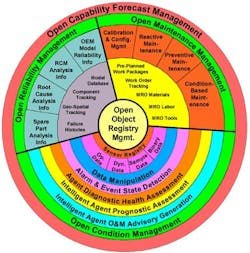Across asset-intensive industries, top management’s demands for lower costs and higher profits have driven increasingly sophisticated maintenance strategies. Reliability and maintenance professionals are making great strides toward shedding calendar-based maintenance activities by using vibration, fluid analysis, thermography, motor circuit analysis, ultrasound testing and other services and technologies.
Condition monitoring is a mature discipline with robust solutions resulting from decades of development. But while developers of computerized maintenance management system (CMMS) or enterprise asset management (EAM) packages are steadily adding capabilities for handling condition-monitoring tasks and opening their technology platforms for greater connectivity, CMMS and condition-monitoring systems still aren’t capable of being plugged directly into each other. To fill the gaps, end-user organizations have turned to a cornucopia of solutions, from database and analytical software solutions to real-time controls, to improve efficiency and reduce risk. When condition monitoring meets management systems, the concept of condition-based maintenance (CBM) becomes possible.
The concept traces back decades in military applications, and represents an ideal that some might say has never been realized. Even the definitions of CBM — and updated “CBM+” — are varied enough to defy an accepted standard. But a simplified, serviceable definition is “Tracking the condition of equipment and assets to perform maintenance activities only when the variables of an asset or piece of equipment indicate the risk of an impending failure.”
Consultant Alan Johnston says, “Historically, CBM has had greater emphasis in aerospace and defense, in the process industries and at utilities, where there’s an extremely high cost related to an unpredicted failure. People can die ... aircraft can crash ... nuclear subs can go boom.” But how are we doing at bringing CBM to bear on the more prosaic problems in typical manufacturing plants?
The MIMOSA architecture supports CBM by facilitating integration of reliability, maintenance and condition management.
Open O&M: Standard of standards
When he’s not at his desk at Alabama’s Redstone Arsenal, Johnston is active as president of the Management Open Systems Alliance (MIMOSA), or chairing Open O&M, a superset of standards groups promoting integration between the worlds of reliability and maintenance with enterprise computing and risk management. Open O&M is an amalgamation of standards groups (ISA, OPC Foundation, WBF and OAGi) whose mission Johnston defines as “a group of standards organizations that have agreed to work with each other to make their standards interoperable, so their products and systems based on those standards will also be interoperable.”
Why is the scope so broad? Because, he explains, “The corporate guys don’t generally come down to the maintenance department and ask those guys for their viewpoint on interoperability standards.” It’s up to maintenance leaders to “step up and be true peer partners with their enterprise systems counterparts in the organization ... If they don’t, decisions will be made without their input.”
The core MIMOSA architecture might well provide the best backbone for CBM by facilitating the integration of three major components: reliability management, maintenance management and condition management (Figure 1). Each of these is broken into pieces. For example, “open condition management” starts with sensors, data input and manipulation, alarms and events, diagnostic health assessment and prognostic assessments.
The current state of automated condition-managing tools, according to Johnston, is at the level of diagnostic health assessments, where vibration tests, portable data collectors and other means are used to collect data, plot trends and analyze the deterioration and usable life span of assets. This is akin to a doctor who knows what’s wrong. But that doctor can’t give a prognosis without a broader knowledge of what’s going on. In a CBM context, even if systems are capable of coming close to root-cause analysis, integration is generally insufficient to close the loop with automation. So, the next frontier for maintenance technology is in this area of prognosis assessment.
Communication and context
Operations and maintenance used to be separate, but management philosophies and advances in technology are bringing them together. Business standards such as industrial Ethernet and Microsoft-based connectivity standards have been adapted for industrial use, and computing intelligence has been distributed down to the lowest levels so that motors and pumps – any asset with a microchip – can be put to work in a CBM
environment.
So it’s no surprise that automation engineers have been broadening their solutions to include maintenance modules. For example, GE Fanuc (www.gefanuc.com) in April announced the addition of a Maintenance Gateway module to its Proficy automation software suite. The system can reside on the plant floor, in the maintenance department or in both places. “It doesn’t matter,” says Mike Yost, Proficy product marketing manager, adding that “the same performance OEE [overall equipment effectiveness] number is seen across the entire platform” for quicker identification and correction of problems.
Similarly, major distributed control system (DCS) suppliers, including Emerson, Honeywell and ABB on the process side, offer what tech-analyst firm ARC Advisory Group (www.arcweb.com) calls a “plant asset management” (PAM) system. PAM software is part of the DCS and directly communicates with sensors to predict failures, alerting the plant users to equipment problems as well as integrating with and sending messages to the EAM/CMMS. Invensys, whose Wonderware plant automation software and Foxboro DCS business units both offer maintenance add-ons, offers arguably the broadest and deepest platform for integration, particularly because it also owns the Avantis EAM system. But integration partnerships abound for those who wish to operate in a CBM environment.
“There’s a lot more intelligence in the field [device] than there ever has been,” says Wil Chin, director of field systems for ARC, citing both ends of the DCS, from smarter sensors and transmitters to more capable DCS software. “They not only can tell you what the process is doing, but how well the performance of the measurement is relative to a given standard.” In the integrated DCS environment, maintenance personnel “no longer have to wait until regular PM rounds,” because the system will track deviations from preset limits based on historic trends to provide health status and trigger alarms in real time.
In general, PAMs don’t offer a unified environment to directly integrate plant and site assets. The Pi enterprise historian and suite of related products from OSIsoft (www.osisoft.com) is a pervasive solution for integrating real-time data, typically in process-industry applications that trend maintenance data. The core function of this product is to manage process data such as analog and digital readings; product, material and batch information; quality information including upper and lower limits; and aggregated process-variable averages.
Some established condition-monitoring suppliers have been acquired by companies also involved in real-time control, such as Rockwell Automation (Entek, for vibration), GE (Bentley Nevada for vibration) and ABB (DLI Engineering for vibration; HSB Reliability Technologies for rotating equipment). The real-time synergy is natural for CBM.
In April 2008, Dow Corning’s Midland, Mich., plant went live in the process with the Stress Wave Analyzer condition monitor from Invensys (www.invensys.com). The technology is an integrated version of SWANtech’s ultrasonic-based “stress wave analysis” condition-monitoring technology, which can be applied as an alternate to vibration, temperature and lubrication debris monitoring tools (http://swantech.curtisswright.com). It’s integrated with the plant’s Foxboro DCS.
The bottom line of DCS-to-condition-monitoring integration is, “As a maintenance or reliability professional, the quicker you can pick up a signal of imminent failure, the better chance you have to cost-effectively manage it,” says Dan Warren, CBM analyst for the Midland plant. His installation is brand-new and not fully expanded throughout the DCS, but he has observed that motors, pumps and other assets can fail in “pretty short duration once they start. So the effect of bringing continuous condition-monitoring into our DCS has allowed us to really dial into finding these problems prior to catastrophic failure.”
Next in the chain: CMMS
Computerized maintenance and asset-management systems have in recent years added features for better usability. With the rise of OEE-driven key performance indicators (KPIs), systems are getting more user-friendly. It’s common for systems to provide operations and maintenance personnel with a panel, or “dashboard,” view of assets using graphs, red-yellow-green indicator lights and similar meters and alarms. These allow the user to view an asset and dig down in the hierarchy to view trends from the plant down through a single asset.
“What we see today with CMMS or EAM applications is that the information is much closer to real time than it was just a couple of years ago,” says Anders Lif, global industry director of manufacturing and logistics for IFS World Operations (www.ifsworld.com), speaking for IFS North America. OEE, which was in the past a lagging indicator of plant uptime and productivity, is now being used as an almost instant indicator of production-line performance. With operations and maintenance personnel increasingly working together, he says, “Business applications and CMMS systems are moving very much toward the same set of rules operators live by in the SCADA [supervisory control and data acquisition] environment.” For that reason, he sees IFS customers seeking both more integration with factory floor systems and KPI-oriented displays.
Systems also have added features for better management of maintenance and, specifically, condition data, such as triggering an alarm or message (on-screen, e-mail, text message) if asset conditions exceed upper or lower control limits, or simply triggering a preventive maintenance (PM) routine if all is well. They can trace multiple variables for a piece of equipment and support Boolean “and/or” logic to configure and display combined indicators. Users also can drill down in the system to validate that when an alarm triggers, it’s not a system error, before responding. This type of user interface provides “just what’s important right there in the browser,” says Paul Stamas, vice president if information technology at Mohawk Fine Paper, Cohoes, N.Y. “If a dial creeps up into the yellow zone, we know we need to view that item in more detail, and think about this valve or that motor, or do some preventive action that will be right behind that dial in the interface. It’s not so much about an event; it’s more about continuous monitoring.”
Mohawk chose a system from Infor (www.infor.com) for its maintenance department, and is considering upgrading to its new Asset Sustainability Edition to perform condition-based predictive tracking of its hybrid continuous, batch and discrete paper-making and converting facilities, which include wind power generation. The system can factor multiple runtime, calculated kilowatt usage down to the asset level, and other indicators to compare design specifications or other benchmarks with actual performance data.
Comparing the energy consumption of two chillers shows that instead of saving $400 per year in parts costs, a less-expensive filter increased annual energy expense by nearly $5,000.
The system isn’t yet installed, but one demonstration considers two pieces of refrigeration equipment (chillers) (Figure 2). They’re identical except that one uses a different filter, which costs $150 less. Both filters are changed every four months. Running this routine for 18 months might show both chillers to be in top working condition when viewed from a traditional maintenance mode, and the less-expensive part would prevail. But, by monitoring energy use, the demonstration shows that the asset with the more expensive filter is running at near-peak efficiency, while the asset with the less-expensive filter degrades to 60% efficiency. Instead of saving roughly $400 annually with a less-expensive filter, the maintenance department finds that the higher-priced filter can save them nearly $5,000 in reduced energy costs.
These benefits point to the great potential for real-time CBM, and how CMMS/EAM system designers are beginning to capitalize on it.
Math in the middle
ARC’s Chin names Ivara (www.ivara.com), Meridium (www.meridium.com) and SmartSignal (www.smartsignal.com) as emerging solutions for advanced maintenance techniques that complement condition-monitoring systems but operate as a generic, or “hardware independent,” layer of software. In Meridium’s words, they provide “a much broader scope of data that isn’t tied to a specific hardware manufacturer.”
Large sites that back their maintenance staffs with reliability engineering are familiar with methodologies such as reliability-centered maintenance (RCM) and failure mode and effects analysis (FMEA). Based on those methods, Ivara puts data in the context of work flows in a unified database environment that can connect to each activity and source of asset health, including “ maintenance and operator inspections, predictive technologies like vibration and lubricant analysis, as well as integration to online sources such as data historians and supervisory control and data acquisition systems,” says Eric Wegscheider, director of product marketing for Ivara. “We bridge the divide between these different islands of data that you’ve already got and bring them together into one supporting platform.”
SmartSignal’s EPI*Center software also serves large, often continuous process-industry sites involving tens of thousands of asset data points. It doesn’t replace systems from Ivara or OSIsoft or others, but can augment them with advanced modeling and pattern-recognition tools that expand “to a tremendous degree” the analysis of “anything that can be measured with any kind of sensors or instrumentation,” says David Bell, vice president of application engineering.
Conditional benefits
Vendors offer tools, but none of them are as important to an organization as the up-front study of its own assets, models of its own work flows, and understanding its operating environment. Along with greater uptime and asset performance, better control of processes can reclaim lost dollars in the form of reduced scrap, better-tuned loops (in process applications) and less variation in product quality.
PM activities often are reduced, but many organizations replace them with human input of the lion’s share of data. The greater efficiency improvement is by reducing unplanned work and, in turn, overtime labor, as well as spare parts inventory. Most importantly, critical failures can be prevented, preserving the business from costly or catastrophic results to its bottom line, operations or human safety.
By advancing CBM and the greater goals of integrated maintenance in the enterprise, Johnston says, “We can’t necessarily solve world hunger, but we can certainly help people solve a much bigger portion of their overall challenges.”


